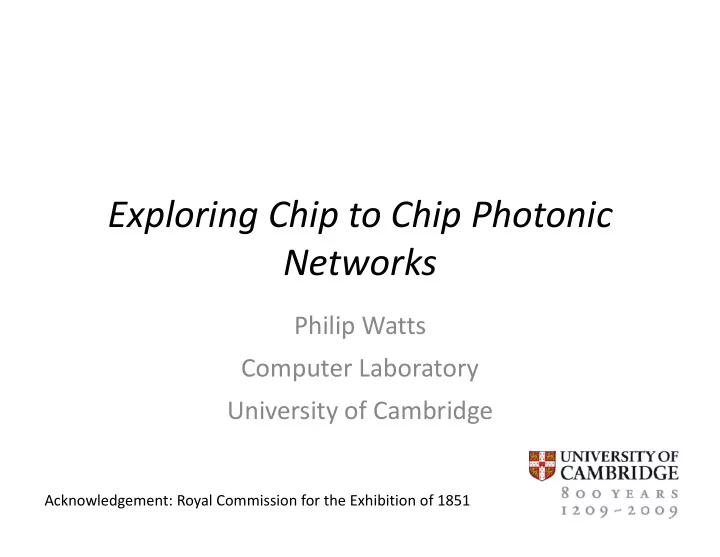

Exploring Chip to Chip Photonic Networks Philip Watts Computer Laboratory University of Cambridge Acknowledgement: Royal Commission for the Exhibition of 1851
Exploring Chip ‐ to ‐ Chip Photonics p g p p • Bandwidth improvements in electronic interconnects have been achieved at the expense interconnects have been achieved at the expense of increased latency and power consumption • Photonics has the potential to reduce power consumption/ latency – Known for a long time, BUT size, cost, manufacturing K f l i BUT i f i issues – Enabling technologies: silicon photonics and 3D Enabling technologies: silicon photonics and 3D integration • Needs a holistic system assessment • Needs a holistic, system assessment – assessing power consumption and performance
Photonics: Low Power and Latency ? • For point ‐ to ‐ point links: – Photonics power consumption is Optical Optical p Transmitters Transmitters not dependent on distance only on not dependent on distance, only on (de)multiplexers modulator/detector capacitance λ 1 Optical Tx • Electrical interconnect power Waveguide increases exponentially with distance λ 2 Tx Tx – Photonics is not pin limited Photonics is not pin limited MUX λ 1 , λ 2 … λ N • Large bandwidth, low latency using by wavelength multiplexing λ N • Switched systems: Switched systems: Tx Tx Processor Switch – Photonics switching power is not λ 1 Fabric Core Rx dependent on bandwidth • Electronic routers, power and latency λ 2 Rx Rx D consumed for each hop/buffer consumed for each hop/buffer EMUX λ 1 , λ 2 … λ N • Electronic/Photonic comparisons are highly dependent on λ N Rx Rx assumptions and application assumptions and application
Enabling Technology 1: Silicon Photonics What’s changed? • Compact waveguides in Si/SiO • Compact waveguides in Si/SiO 2 – Compact and low cost Source: Intel • Off ‐ chip, polymer waveguides – Integration on Copper PCBs 1.4m long spiral polymer waveguide with input from HeNe laser • Ring resonators can g modulate, switch and filter – Switch/Modulate at >10Gb/s Appropriate detectors and light ‐ sources already exist Diagram: M. Lipson (Cornell)
Enabling Technology 2: 3D Integration • Recent advances in 3D point toward multiple cores + DRAM layers ( ≈ 1 GB) + network within a single package • Combine such modules to produce larger systems for data centres or high performance computing • III ‐ V substrates for light sources can be integrated Polymer Waveguides Opti “Intra ‐ system” or “Inter ‐ system” or data centre model HPC model cal Backplane MEMORY CORES CACHE CACHE CORES MEMORY NETWORK NETWORK 3D Chip Models Optical PCB
Characteristics of a Photonic Network • Photonic Limitations: – Signals can not be (practically) buffered Signals can not be (practically) buffered – Difficult to read header and setup switch on the fly • These limitations leads naturally to circuit switching h l l d ll h (with edge buffers) – Photonics is good for flows/large packets h d f fl /l k – Relatively inefficient for small packets (e.g. cache lines) • Obvious network choice: Central Xbar/Clos switch with time slot access, e.g. SWIFT (Intel/Cambridge) g ( g ) – Various alternative distributed approaches proposed
FPGA ‐ based Full System Emulation • FPGA ‐ based emulation enables full system power/performance data using realistic workloads/timescales using realistic workloads/timescales – 100x faster than software simulation – Existing Computer Lab project, C3D, provides BEE3 infrastructure, cores and all electronic reference design all ‐ electronic reference design • Emulate 1000+ core computer with photonic chip ‐ to ‐ chip network model – 4 high ‐ end FPGAs per board – 4 ‐ 8 MIPS ‐ 64 cores per FPGA – Clock rate ≈ 100 MHz • Levels of model abstraction – Parameterisable and synthesisable SystemVerilog network model Features of BEE3 board Features of BEE3 board – Photonic component power Ph t i t consumption model (UC Berkeley/Microsoft) – Photonic path viability model
Exploring Chip ‐ to ‐ chip Photonics • Collaborators: Myself, Andrew Moore, Simon Moore (Cambridge), Robert Killey (UCL EE) (Cambridge), Robert Killey (UCL EE) • Program to investigate implications of chip ‐ to ‐ chip photonic interconnect on architecture of: photonic interconnect on architecture of: – Data Centres – High Performance Computing • Build accurate and experimentally verified models of latest silicon photonics components (UCL) p p ( ) • Build full system FPGA ‐ based emulator – Allows rapid network architectural exploration Allows rapid network architectural exploration – Find applications which benefit from photonic networks
Recommend
More recommend